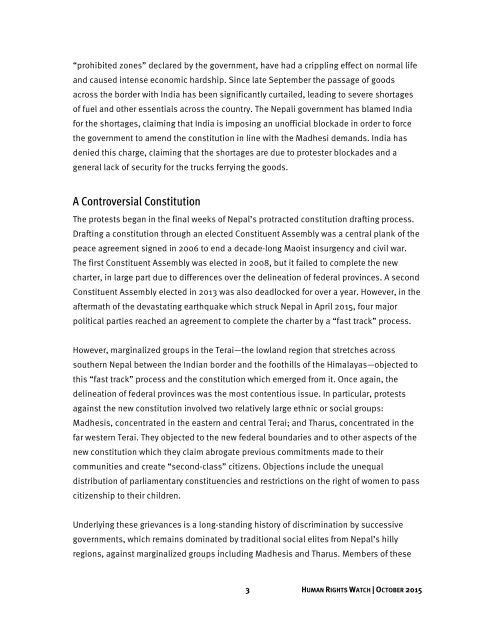“Like We Are Not Nepali”
7KiiNLWaT
7KiiNLWaT
You also want an ePaper? Increase the reach of your titles
YUMPU automatically turns print PDFs into web optimized ePapers that Google loves.
“prohibited zones” declared by the government, have had a crippling effect on normal life<br />
and caused intense economic hardship. Since late September the passage of goods<br />
across the border with India has been significantly curtailed, leading to severe shortages<br />
of fuel and other essentials across the country. The Nepali government has blamed India<br />
for the shortages, claiming that India is imposing an unofficial blockade in order to force<br />
the government to amend the constitution in line with the Madhesi demands. India has<br />
denied this charge, claiming that the shortages are due to protester blockades and a<br />
general lack of security for the trucks ferrying the goods.<br />
A Controversial Constitution<br />
The protests began in the final weeks of Nepal’s protracted constitution drafting process.<br />
Drafting a constitution through an elected Constituent Assembly was a central plank of the<br />
peace agreement signed in 2006 to end a decade-long Maoist insurgency and civil war.<br />
The first Constituent Assembly was elected in 2008, but it failed to complete the new<br />
charter, in large part due to differences over the delineation of federal provinces. A second<br />
Constituent Assembly elected in 2013 was also deadlocked for over a year. However, in the<br />
aftermath of the devastating earthquake which struck Nepal in April 2015, four major<br />
political parties reached an agreement to complete the charter by a “fast track” process.<br />
However, marginalized groups in the Terai—the lowland region that stretches across<br />
southern Nepal between the Indian border and the foothills of the Himalayas—objected to<br />
this “fast track” process and the constitution which emerged from it. Once again, the<br />
delineation of federal provinces was the most contentious issue. In particular, protests<br />
against the new constitution involved two relatively large ethnic or social groups:<br />
Madhesis, concentrated in the eastern and central Terai; and Tharus, concentrated in the<br />
far western Terai. They objected to the new federal boundaries and to other aspects of the<br />
new constitution which they claim abrogate previous commitments made to their<br />
communities and create “second-class” citizens. Objections include the unequal<br />
distribution of parliamentary constituencies and restrictions on the right of women to pass<br />
citizenship to their children.<br />
Underlying these grievances is a long-standing history of discrimination by successive<br />
governments, which remains dominated by traditional social elites from Nepal’s hilly<br />
regions, against marginalized groups including Madhesis and Tharus. Members of these<br />
3 HUMAN RIGHTS WATCH | OCTOBER 2015


